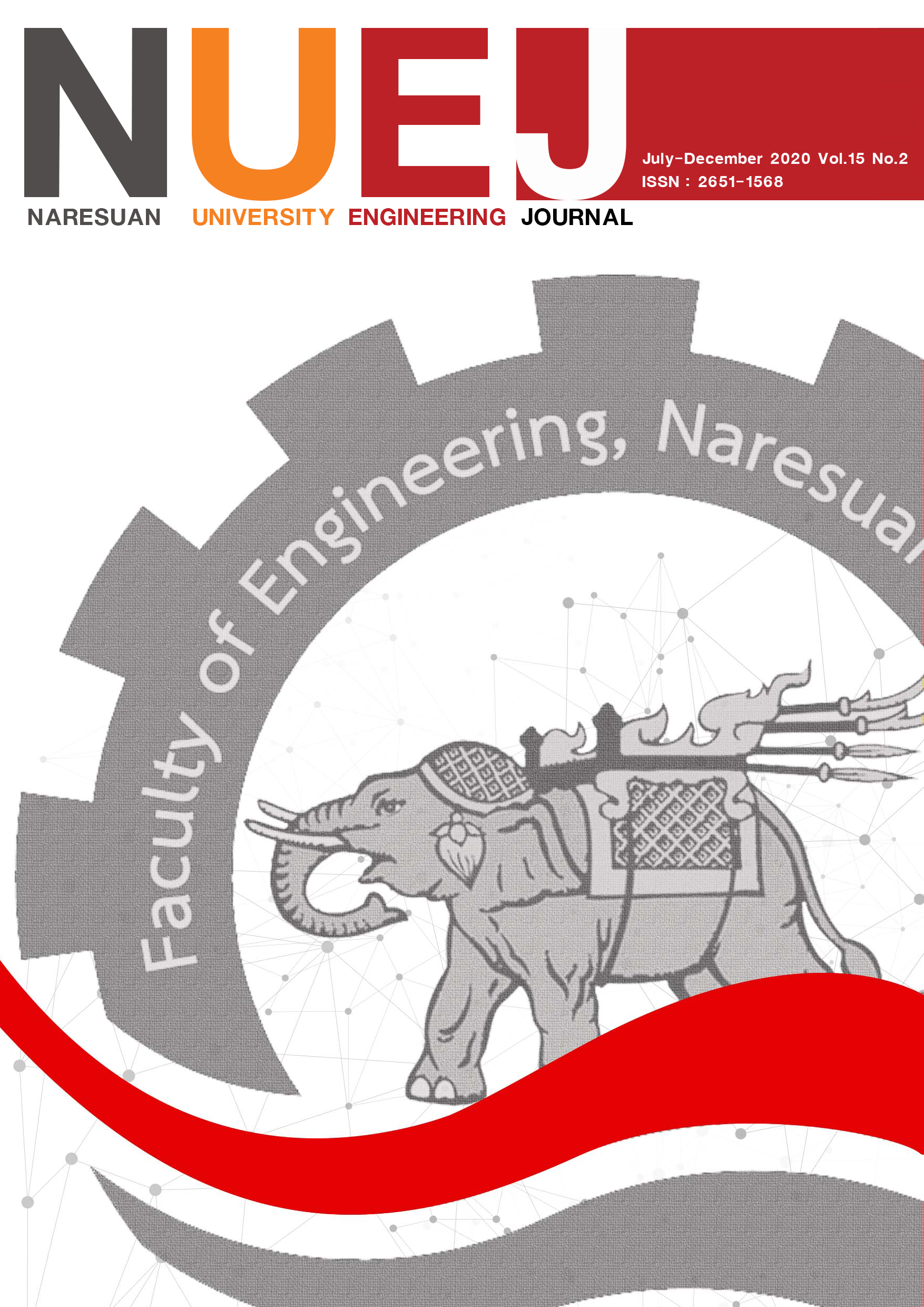Factors Affecting Compressive Strength of Geopolymer Concrete from Bagasse Ash Mixed with Aluminum Dust
Main Article Content
Abstract
The aim of this research is utilization the bagasse ash, a waste material from sugar factories, as a precursor to producing geopolymer concrete. According to the bagasse ash has a lot of silica elements but has little alumina therefore use aluminum dust as waste material to add alumina in the geopolymer with bagasse ash as raw materials. This research uses bagasse ash from 2 sources, replacing bagasse ash with aluminum dusts 0-1.0% by weight. Ratios of alkaline solution to source material (AL/BA) 0.50-0.65 by weight. Curing temperatures of sample were 60, 80 and 100 °C. From the research, the source of bagasse ash greatly affected the compressive strength of geopolymer concrete. The replacement of bagasse ash with suitable aluminum dusts was 0.40% by weight made the highest compressive strength. The low AL/BA ratios tended to give higher compressive strength but decreased the slump. The high temperature curing effected on the high compressive strength of concrete at early age. However, at any curing temperatures, the compressive strength were similar as the later age of concrete samples. The compressive strength of geopolymer concrete from this research reached to 300 ksc.
Article Details
References
Chindaprasirt, P., Chareerat, T., & Khunawanakit, W. (2008). Geopolymer from Mae Moh fly Ash. Engineering and Applied Science Research (EASR), 32(5), 715 724.
Chusilp, N., Jaturapitakkul, C., & Kiattikomol, K. (2009). Effects of LOl of ground bagasse ash on the compressive strength and sulfate resistance of mortars. Construct Build Mater 23, 3523 3531.
Cordeiro, G. C., Toledo Filho, R. D., Tavares, L. M., & Fairbairn, E. M. R. (2008). Pozzolanic activity and filler effect of sugar cane bagasse ash in Portland cement and lime mortars. Cement and Concrete Composites, 30(5), 410 418.
CPAC Concrete Academy. (2013). Concrete Technology. Chap ter18: Concrete Mixing Design. https://www.cpacacademy.com
Dobrowolski, T. (2011). The dynamics of the kink in curved large area josephson junction. Discrete and Continuous Dynamical Systems - Series S, 4(5),1095 1105. https://doi.org/10.1016/j.conbuildmat.2015.11.045
Dter, T. (2014). Concrete durability. Taylor & Francis Group.
Fairbairn, E. M. R., Americano, B. B., Cordeiro, G. C., Paula, T. P., Toledo Filho, R. D., & Silvoso, M. M. (2010). Cement replacement by sugar cane bagasse ash: CO2emissions reduction and potential for carbon credits. Journal of Environmental Management, 91(9), 1864––1871. https:// doi.org/10.1016/j.jenvman.2010.04.008
Ganesan, A., & Rajagopal, K. (2007). Evaluation of bagasse as corrosion resisting admixture for carbon steel in concrete. Anti-Corros Methods Mater 54, 230--236.
Office of the Cane and Sugar Board, Ministry of Industry Thailand. (2016). Report of sugar cane and sugar production. http://www.ocsb.go.th
Rattanasak, P. & Chindaprasirt, P. (2008). Study of geopolymer from fly ash. Journal of Industrial Technology, 8(2), 1–8.
Rukzon, S., & Ngenprom, N. (2010). The development of rice husk ash and bagasse ash based geopolymeric materials. Rajamangala University of Technology Phra Nakhon Intellectual Repository.
Singh, N. B., Singh, V. D., & Sarita, R. (2000). Hydration of Bagasse Ash-blended Portland Cement. Cement and Concrete Research, 30, 1485--1488.
Somna, R., & Jaturapitakkul, C. (2011). Use of Ground Bagasse Ash to Improve Compressive Strength, Water Permealibity, and Chloride Resistance of Recycled Aggregate Concrete. KMUTT Research and Development Journal, 34(4), 369--381.
Sujjavanich, S. (2003). Effect of bagasse ash on binder characteristics. Kasetsart Engineering Journal (Thailand), 48, 18--22.
Turner, L. K., & Collins, F. G. (2013). Carbon dioxide equivalent (CO2--e) emissions: A comparison between geopolymer and OPC cement concrete. Construction and Building Materials, 43, 125––130. https://doi.org/10.1016/j.conbuildmat.2013.01.023
Villar-Cocifta, E., Frias, M., & Valencia, E. (2008). Sugar cane wastes as pozzolanic materials: application of mathematic model. Aci Materials Journal, 105, 258--264.
Witoteerasan, W., Homwuttiwong, S., & Wongpa, J. (2014). Geopolymer Mortar Production from Waste Materials. Engineering Journal Chiang Mai University, 21(1), 1--9.
Wongpa, J. (2009). Development of ash from industrial plants to replace Portland cement. Research community, 85, 75––76.
Zhou, W., Yan, C., Duan, P., Liu, Y., Zhang, Z., Qiu, X., & Li, D. (2016). A comparative study of high- and low-Al2O3fly ash based-geopolymers: The role of mix proportion factors and curing temperature. Materials and Design, 95, 63––74. https://doi.org/10.1016/j.matdes.2016.01.084


